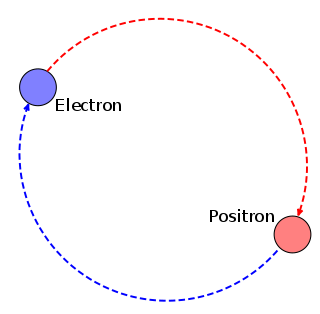
A muon is an elementary particle similar to the electron, with an electric charge of −1 e and a spin of 1/2, but with a much greater mass. It is classified as a lepton. As with other leptons, the muon is not thought to be composed of any simpler particles; that is, it is a fundamental particle.

Muonium is an exotic atom made up of an antimuon and an electron, which was discovered in 1960 by Vernon W. Hughes and is given the chemical symbol Mu. During the muon's 2.2 µs lifetime, muonium can undergo chemical reactions. Because, like a proton, the antimuon's mass is vastly larger than that of the electron, muonium is more similar to atomic hydrogen than positronium. Its Bohr radius and ionization energy are within 0.5% of hydrogen, deuterium, and tritium, and thus it can usefully be considered as an exotic light isotope of hydrogen.

Particle physics or high-energy physics is the study of fundamental particles and forces that constitute matter and radiation. The field also studies combinations of elementary particles up to the scale of protons and neutrons, while the study of combination of protons and neutrons is called nuclear physics.

Positronium (Ps) is a system consisting of an electron and its anti-particle, a positron, bound together into an exotic atom, specifically an onium. Unlike hydrogen, the system has no protons. The system is unstable: the two particles annihilate each other to predominantly produce two or three gamma-rays, depending on the relative spin states. The energy levels of the two particles are similar to that of the hydrogen atom. However, because of the reduced mass, the frequencies of the spectral lines are less than half of those for the corresponding hydrogen lines.
An exotic atom is an otherwise normal atom in which one or more sub-atomic particles have been replaced by other particles of the same charge. For example, electrons may be replaced by other negatively charged particles such as muons or pions. Because these substitute particles are usually unstable, exotic atoms typically have very short lifetimes and no exotic atom observed so far can persist under normal conditions.

In particle physics, a lepton is an elementary particle of half-integer spin that does not undergo strong interactions. Two main classes of leptons exist: charged leptons, and neutral leptons. Charged leptons can combine with other particles to form various composite particles such as atoms and positronium, while neutrinos rarely interact with anything, and are consequently rarely observed. The best known of all leptons is the electron.

The tau, also called the tau lepton, tau particle, tauon or tau electron, is an elementary particle similar to the electron, with negative electric charge and a spin of 1/2. Like the electron, the muon, and the three neutrinos, the tau is a lepton, and like all elementary particles with half-integer spin, the tau has a corresponding antiparticle of opposite charge but equal mass and spin. In the tau's case, this is the "antitau". Tau particles are denoted by the symbol
τ−
and the antitaus by
τ+
.

The Large Hadron Collider (LHC) is the world's largest and highest-energy particle collider. It was built by the European Organization for Nuclear Research (CERN) between 1998 and 2008 in collaboration with over 10,000 scientists and hundreds of universities and laboratories across more than 100 countries. It lies in a tunnel 27 kilometres (17 mi) in circumference and as deep as 175 metres (574 ft) beneath the France–Switzerland border near Geneva.
A collider is a type of particle accelerator that brings two opposing particle beams together such that the particles collide. Colliders may either be ring accelerators or linear accelerators.

The Budker Institute of Nuclear Physics (BINP) is one of the major centres of advanced study of nuclear physics in Russia. It is located in the Siberian town Akademgorodok, on Academician Lavrentiev Avenue. The institute was founded by Gersh Budker in 1959. Following his death in 1977, the institute was renamed in honour of Budker.

The LHCb experiment is a particle physics detector experiment collecting data at the Large Hadron Collider at CERN. LHCb is a specialized b-physics experiment, designed primarily to measure the parameters of CP violation in the interactions of b-hadrons. Such studies can help to explain the matter-antimatter asymmetry of the Universe. The detector is also able to perform measurements of production cross sections, exotic hadron spectroscopy, charm physics and electroweak physics in the forward region. The LHCb collaboration, who built, operate and analyse data from the experiment, is composed of approximately 1650 people from 98 scientific institutes, representing 22 countries. Vincenzo Vagnoni succeeded on July 1, 2023 as spokesperson for the collaboration from Chris Parkes. The experiment is located at point 8 on the LHC tunnel close to Ferney-Voltaire, France just over the border from Geneva. The (small) MoEDAL experiment shares the same cavern.

Muon spin spectroscopy, also known as µSR, is an experimental technique based on the implantation of spin-polarized muons in matter and on the detection of the influence of the atomic, molecular or crystalline surroundings on their spin motion. The motion of the muon spin is due to the magnetic field experienced by the particle and may provide information on its local environment in a very similar way to other magnetic resonance techniques, such as electron spin resonance and, more closely, nuclear magnetic resonance (NMR).
The
B
s meson is a meson composed of a bottom antiquark and a strange quark. Its antiparticle is the
B
s meson, composed of a bottom quark and a strange antiquark.
The timeline of particle physics lists the sequence of particle physics theories and discoveries in chronological order. The most modern developments follow the scientific development of the discipline of particle physics.
Quantum electrodynamics (QED), a relativistic quantum field theory of electrodynamics, is among the most stringently tested theories in physics. The most precise and specific tests of QED consist of measurements of the electromagnetic fine-structure constant, α, in various physical systems. Checking the consistency of such measurements tests the theory.

An onium is a bound state of a particle and its antiparticle. These states are usually named by adding the suffix -onium to the name of one of the constituent particles, with one exception for "muonium"; a muon–antimuon bound pair is called "true muonium" to avoid confusion with old nomenclature.
High-precision experiments could reveal small previously unseen differences between the behavior of matter and antimatter. This prospect is appealing to physicists because it may show that nature is not Lorentz symmetric.
A Muon Collider is a proposed particle accelerator facility in its conceptual design stage that collides muon beams for precision studies of the Standard Model and for direct searches of new physics. Muons belong to the second generation of leptons, they are typically produced in high-energy collisions either naturally or artificially. The main challenge of such a collider is the short lifetime of muons.
The Mu to E Gamma (MEG) is a particle physics experiment dedicated to measuring the decay of the muon into an electron and a photon, a decay mode which is heavily suppressed in the Standard Model by lepton flavour conservation, but enhanced in supersymmetry and grand unified theories. It is located at the Paul Scherrer Institute and began taking data September 2008.
Monitored neutrino beams are facilities for the production of neutrinos with unprecedented control of the flux of particles created inside and outside the facility.










